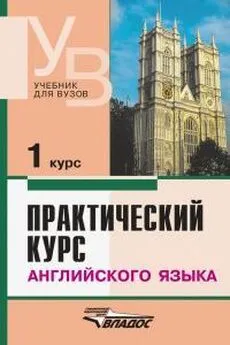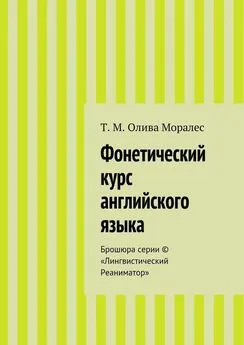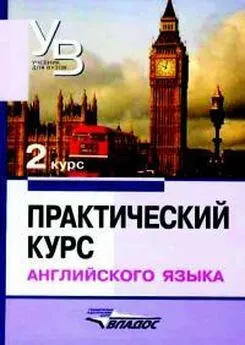Владимир Аракин - Практический курс английского языка 1 курс
- Название:Практический курс английского языка 1 курс
- Автор:
- Жанр:
- Издательство:ВЛАДОС
- Год:1998
- ISBN:нет данных
- Рейтинг:
- Избранное:Добавить в избранное
-
Отзывы:
-
Ваша оценка:
Владимир Аракин - Практический курс английского языка 1 курс краткое содержание
I - V курсов педагогических вузов.
Цель учебника – обучение устной речи на основе развития необходимых автоматизированных речевых навыков, развитие техники чтения, а также навыков письменной речи.
Практический курс английского языка 1 курс - читать онлайн бесплатно полную версию (весь текст целиком)
Интервал:
Закладка:
sentences below. Pronounce them with Intonation Pattern 111.Say what attitude you mean to
render:
What do you think of the picture?
Do you play the piano?
Do you think the English climate is
changeable?
Why is your garden so beautiful?
Do women smoke?
Do students dance?
Do you do your morning exercises?
What's your nationality?
What does it cost?
Where are you going next week?
When's your birthday?
What's your hobby?
What's your favourite month?
Do you speak French?
Can you call on me tomorrow night?
Will you be able to do it?
Nobody goes to see him.
Pity, they didn't like it.
Did she see him yesterday?
How many English books have you got?
Will he ring her up?
Do you get up early in the morning?
Thank you very much.
What are they doing? He is at home after four. You should do it like this.
Which is Benny's coat? Lucy is coming to Moscow. Where shall we meet? I stop
here. I'm thirty.
You should write to her at once.
Come round at five.
Who gave it to you? I'll finish it by Sunday.
Fine.
No.
Quite.
Work.
Some.
Many.
Sometimes.
Russian.
Fourpence.
Moscow.
Monday.
Music.
January.
Certainly.
Maybe.
Probably I shall.
Mother does.
I like it.
She did.
A few.
Perhaps.
As a rule.
You're welcome.
It was nothing.
What?
When?
How?
Which?
Who?
Where?
Why, may I ask? -How old are you? Who should I write to?
What time do you want me to come? Who gave it to me? By what day?
He is a writer.
Your train goes from King's Cross station.
The train leaves at two.
The pen is in that box.
Someone wants you on the phone.
He wasn't there.
There's a concert this evening at the club,
I can't go there.
I'm making a new dress.
We haven't been to the club for ages.
I'm sure it's the plug.
We're going to be late, I'm afraid.
I've entered this Institute.
I wasn't lucky at the exams.
She has some palatalization of the sound
[ml in the word "milk".
Everybody is present today.
[Photographer to sitter.)
What shall we do to improve our English?
(Sister to small brother who is overexcited.)
(Mother to child.)
(Father to son who is learning to drive a car.) (Girl to her small
sister who is teasing a cat.) John says he can't come. We'll be there by seven.
Something has gone wrong with my electric iron. Can you put it right? Here you
are.
Ann, please bring some more milk from
the kitchen.
Your book, Mary.
Good morning, Tom,
I've passed this exam.
He is seriously ill.
I can't see it from behind you.
Hallo, Jane.
He is what?
From which station?
At what time?
In what box?
Who is it?
Where was he then?
Is there?
Can't you?
Are you?
Haven't we?
Is it?
Are we?
Have you?
Weren't you?
Has she?
Really?
Still.
Read.
Careful.
Careful.
Slowly.
Gently.
Oh! (Why not?)
Well!
Of course!
Thanks! Right!
Thank you!
Morning!
Wonderful!
Pity!
Pardon!
Hallo!
8. Pronounce the drill sentences with Intonation Pattern I. Observe the difference in
attitude.
9. Your teacher will suggest a verbal context. You in turn respond* to it using
Intonation Pattern III. The drill will continue until every studMt has participated.
Keep the exercise moving rapidly.
Reference material for the teacher.
M o d e l : Pm well now. ,Are
you?
1. She is at home. 2. It's already six. 3.1 can come at nine. 4. She is leaving
tomorrow. 5. Tom is coming on Saturday. 6. Jane is at home. 7. I've got "good" in
English. 8. I'm going now. 9.1 must leave you. 10. I've no mistakes. 11. My
brother is a doctor. 12. I'm already twenty. 13. I see him very often. 14. She is
waiting for you. 15. Helen is ill, 16. I don't like this book. 17. She is from the
Crimea. 18.1 can't help you. 19. You have too many mistakes. 20. I can't switch
on the cassette-recorder.
10. Your teacher will suggest a verbal context. You in turn respond by using: a)
statements, sounding non-final, encouraging further conversation or reserving some
judgement; b) special questions, sounding wondering or mildly puzzled; c) general
questions, sounding disapproving or sceptical; d) imperatives, calmly warning,
soothing; e) exclamations, encouraging further conversations, expressing calm, casual
acknowledgement or reserving some judgement.
11. Make up a micro-dialogue. Your fellow-student will suggest a verbal context.
Respond by using Intonation Patterns I, II, 111. Continue the talk.
12. "*1 Listen carefully to the following sentences and repeat them in the intervals.
Observe quick pronunciation of unstressed syllables:
I didn't believe it was true.
I'm perfectly certain you're
right.
I didn't think it was true.
I'm almost certain you're
right.
I don't think it was true.
I'm quite certain you're right.
What a sensible piece of advice. He's the happiest man in the
world.
What a useful piece of advice. He's the nicest man in the
world.
What a wise piece of advice.
He's the best man in the
world.
1 Material for exercises marked with three asterisks is borrowed from the book
"Lingaphone English Course". L., 1960.
13."* This exercise is meant to develop your ability to hear the intonation and
reproduce it in proper speech situations, a) Listen to the dialogue "Days and Months.
Asking the Time" sentence by sentence. Write it down. Mark the stresses and tunes.
Practise the dialogue, b) Record your reading, play the recording back immediately
for your teacher and fellow-students to detect the errors in your pronunciation.
Practise the dialogue for test reading and memorize it.
Section Four
Intonation Pattern IV
(LOW PRE-HEAD + ) DESCENDING HEAD 4- LOW RISE (-f TAIL)
—
M o d e l 1: Alice is leaving.
V Does she "want to 'go to the ,Park?
M o d e l 2: That 'sall you were going to buy, isn't it? — Pve Vonly 'got to 'buy
something for , supper.
(LOW PRE-HEAD + ) HIGH LEVEL HEAD + LOW RISE ( + TAIL)
M o d e l : Don't be so slow. — I'll ™> try to be ,quicker.
— t«
• ______________________________________________________________________________________________________________________________________•
This intonation pattern is used:
l . I n s t a t e m e n t s , not categoric, non-final, soothing, reassuring, (in
echoes) questioning, sometimes surprised.
e. g. Pve made a lot of mistakes It's -»not so ,bad.
in my dictation, haven't I?
He's already left.
Al-> ready ,Ieft.
2. In questions:
a) I n s p e c i a l q u e s t i o n s , expressing sympathy, interest; with
the nuclear tone on the interrogative word, puzzled.
e g. I'm leaving tomorrow. -»What, time are youleaving? I've just seen
him in the You've -»seen him , where?
dean's office.
I've lost the key, mother. VHow did you 'manage to 'do
,that?
b) I n g e n e r a l q u e s t i o n s , expressing interest (most common
pattern for general questions).
e. g, I've packed the things. VAre you'ready to ,leave?
3. I n i m p e r a t i v e s , soothing, encouraging, calmly patronising (often
addressed to children).
e. g. What shall I do?
-»Don't , worry.
I'm leaving.
V Put 'on your 'warm,clothes.
4. I n e x c l a m a t i o n s , encouraging, airy, often used in leave-takings
and in bright and friendly greetings.
e. g. Here is my translation. Wery 'well ,done!
Anything else?
Читать дальшеИнтервал:
Закладка:





![Владимир Аракин - Практический курс английского языка 3 курс [calibre 2.43.0]](/books/1072035/vladimir-arakin-prakticheskij-kurs-anglijskogo-yazyk.webp)




